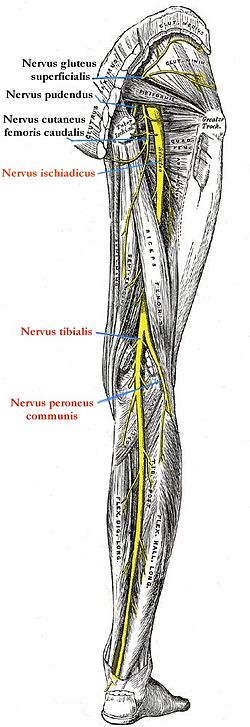Sciatic nerve palsy
From WikiLectures
Image of polio[edit | edit source]
- the leg cannot be flexed at the knee (damage to the flexors on the back of the thigh)
- in the case of complete damage to both main branches, the manifestation is a weakening of the dorsal and plantar flexion of the leg
- isolated damage to the peroneus nerve is more common (localization closer to the surface of the body, disproportionately smaller vascular supply to its size and greater traction during its course)
Causes[edit | edit source]
- trauma - dislocation and fractures of the pelvis, posterior dislocation of the hip joint
- iatrogenic damage - intraoperatively during hip alloplasties (mechanism of compression, traction or ischemia), incorrect application of i.m. injection into the buttock region (especially in cachectic patients and children)
- oppression - unconscious patients, hematomas in the gluteal area, tumors
- piriformis m. syndrome - manifests itself as pain in the buttock region with radiation to the hip and thigh
Links[edit | edit source]
Related Articles[edit | edit source]
- Sacral plexus
- Schiadic nerve
- Communis peroneus nervus palsy
- Tibialis nerve palsy
- Peripheral nerve involvement syndromes
Source[edit | edit source]
- PASTOR, Jan. Langenbeck's medical web page [online]. [cit. 2009]. <https://langenbeck.webs.com/>.
- AMBLER, Zdeněk – BEDNAŘÍK, Josef, et al. Klinická neurologie : část speciální. II. 1. edition. Praha : Triton, 2010. ISBN 978-80-7387-389-9.

